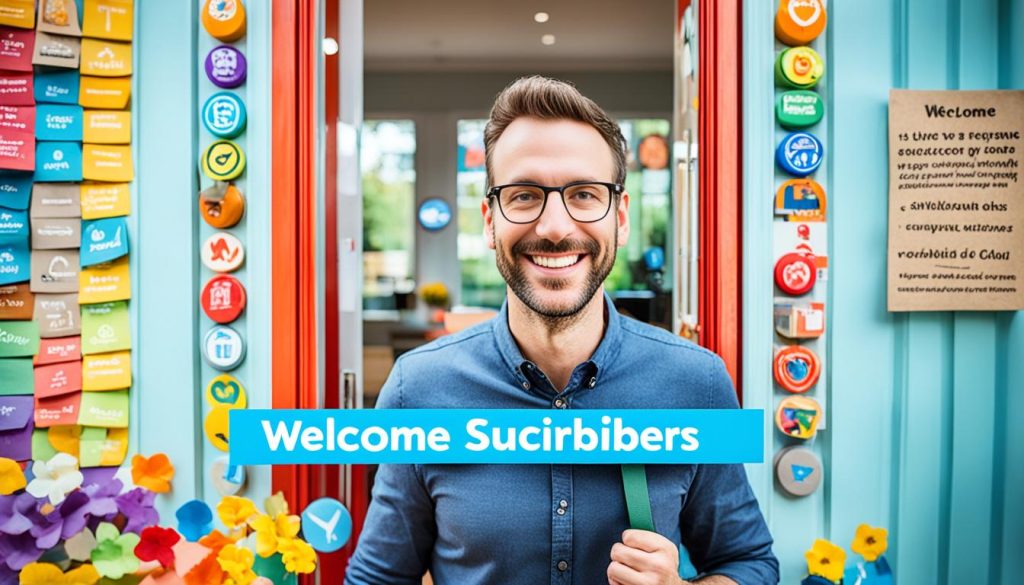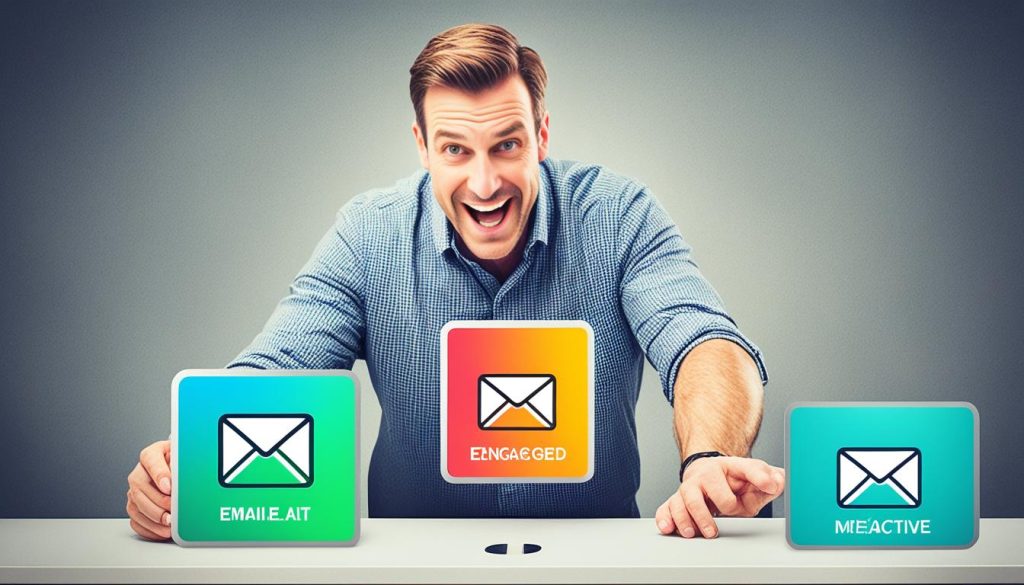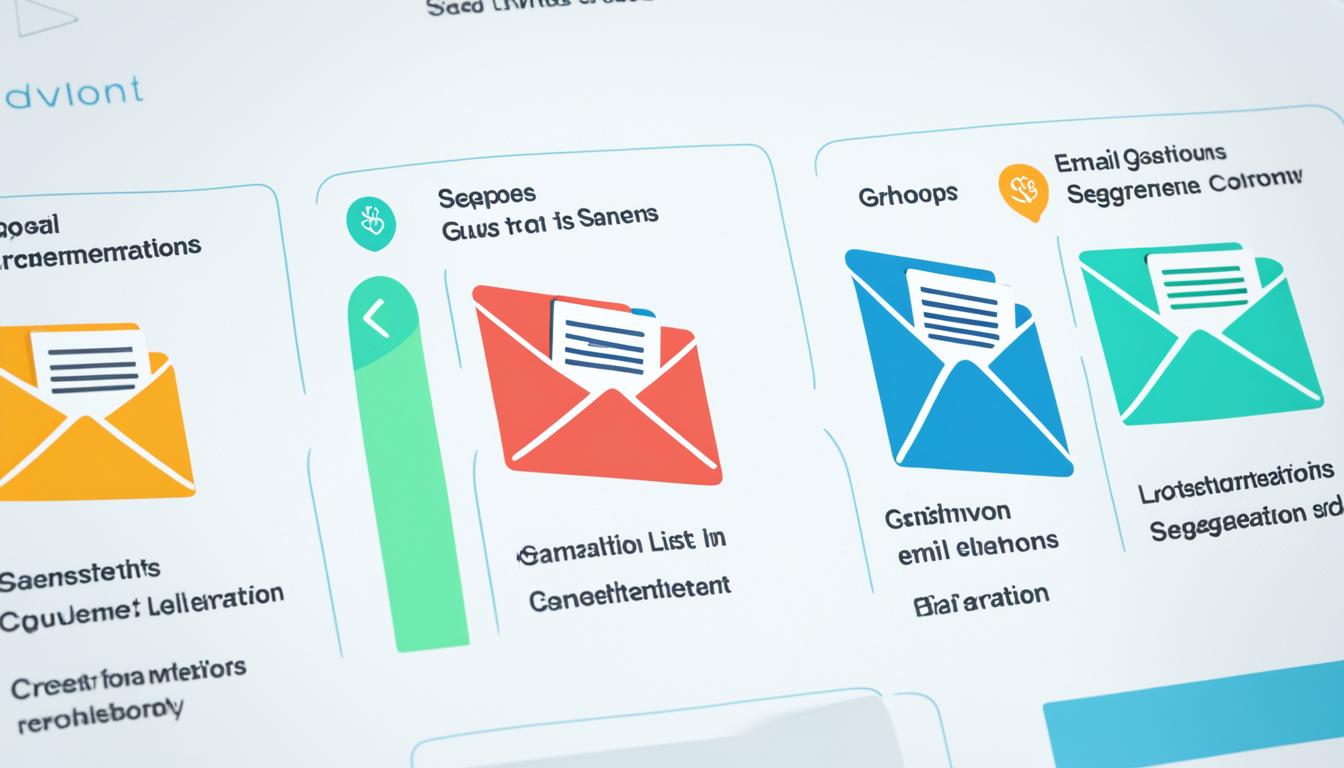Each month, a hot new product is promoted to you. Your inbox fills with emails about new stuff and deals. Even if you see you’ve got lots of unread emails, email marketing is still effective. The real trick is using email segmentation. This means splitting your email list into groups based on what they like, do, or who they are.
We’ve used this method working in both university recruitment and digital marketing. In this guide, we’ll explain more about email list segmentation. We’ll tell you when it’s useful and how to do it. Segmentation can really supercharge your email marketing efforts.
So, what’s the quick fix to improve your emails? The key is segmenting your email list. But what does that mean, and why is it key? We’ll delve into email segmentation. You’ll see the powerful effects it can have on your email marketing strategies.
What is Email Segmentation?
Email segmentation, or list segmentation, is about dividing email receivers into smaller, specific groups. You then share only the most on-point information with them. These groups can be sorted by behavior or demographics, such as where they live, past buys, or site actions. The main goal of segmentation is to personalize emails. The better you segment, the more relevant info your audience gets. This means more sales and happy customers.
Definition of Email Segmentation
You categorize your email list into groups by common traits or actions. This helps you send messages tailored to each group, not a one-size-fits-all note. When you know what each group finds appealing, you can create emails that really speak to them. This boosts how well your messages connect and the outcomes they bring.
Key Benefits of Segmentation
Email segmentation has a lot of perks, such as better open rates and more clicks, buys, and ROI. It also keeps more of your audience with you, lowers the chance they’ll opt out, and helps your emails land in the right inboxes. Segmented campaigns see more opens and personal emails make up over half of sales. Sending more personal emails helps you keep customers around and happy.
Importance of Email List Segmentation
Email lets us send focused messages to small groups. We don’t have to send the same message to everyone. This way, list segmentation boosts open rates by 46%. It also helps increase revenue by 58% with personalized emails.
Better Campaign Results
Segmenting emails helps them get through spam filters. It makes people more likely to open and read them. This means we can create deeper connections with our audience and keep them loyal.
Improved Deliverability
The Lyris report found that segmenting leads to better email performance. It revealed higher open rates, lower unsubscribe rates, and an increase in revenue for 24% of marketers.
Stronger Customer Relationships
Research by HubSpot shows how targeted emails lead to more clicks. They outperform general emails by 8%. And Jupiter Research says relevant emails bring in 18 times more money than non-targeted ones.
Types of Email Segmentation
Email segmentation is about using data to personalize emails. This data includes info like where people are from, their interests, and what they buy. We can split our email lists into groups based on this info to send better-targeted messages.
Demographic Segmentation
Imagine knowing your customers not just by name, but also by their age, where they live, and what they do for a living. This is the power of demographic segmentation. It’s about categorizing customers based on easy to find, basic facts. This kind of grouping doesn’t need a deep dive into their buying history or habits.
Psychographic Segmentation
Psychographic segmentation takes it a step further. It looks into what customers value and how they live their lives. Knowing this, we can send them emails that truly speak to their interests and lifestyles. It’s a deeper way to customize our email content for better engagement.
Behavioral Segmentation
Next, there’s behavioral segmentation. This method involves studying what customers do. For instance, it looks at their buying history and what they do on your website. You might categorize customers who buy certain items and recommend similar products, making your emails more personal and targeted.
Geographic Segmentation
Locational email list segmentation is crucial, especially for local-focused businesses. It means sending messages that fit the area your customers are in. This way, your offers and messages can be finely tuned to meet their local needs.
To succeed in email marketing, make sure to use the data smartly. Pick segmentation methods that fit your strategy. Also, clean your lists regularly to keep them effective.
Segmenting Your Email List
There are many ways to break down our email list for better communication. We can organize by things like age, location, or what people have bought before. This is called demographic segmentation and behavioral segmentation.
We could also group them based on their loyalty, how engaged they are with our emails, or where they are in the buying process. The goal is to group them in ways that make our messages really connect with them.
One idea is to target people who have bought from us before with similar offers. This makes purchase history really useful. Or we could try to get back in touch with those who haven’t been opening our emails lately. The sky’s the limit on how we can tweak our lists to make better connections.
Spending time to really understand our audience can make a big difference. Customizing our emails to fit what each group likes means they’ll pay more attention to us. This boosts how many people open our mails and actually act on them.
It’s important to always keep an eye on how we’re doing. Using different ways to sort our lists and seeing what works best helps us get better. With good tools, we can make our emails really hit the mark and make people feel like they’re hearing what’s just for them.
Welcome New Subscribers with Onboarding Emails
Creating a special email segment for those who joined in the last month is smart. These people are vital for Segmenting Your Email List. By setting up onboarding emails for them, new subscribers get to know your brand well. This is done through Email Personalization and Email Engagement Optimization. The emails introduce your brand, highlight what you offer, and aim to turn these new subscribers into loyal customers.
Greet and involve your new subscribers right from the start to form a strong, lasting bond. This method includes Email Subscriber Profiling and Email List Hygiene techniques. They ensure your Targeted Email Campaigns really speak to your readers. Plus, the use of Audience Segmentation Best Practices like this can boost your List Segmentation Techniques. It also helps your Email Automation Tools work better overall.

Reward Loyal Customers
Loyal customers are like gold for your email marketing efforts. By knowing who your biggest fans are, you can offer them great deals, first dibs on new stuff, and members-only content. This keeps them happy and coming back for more.
Take Caraa, a handbag brand from New York. Their email with surprise bonus points got a lot of people clicking. And Doe Lashes made their emails personal by showing how many points each customer had. This simple step grew their audience.
Tiered loyalty programs help you learn more about what your customers want. For example, Sukoshi Mart sent special deals to their VIP members, boosting sales. Ella + Mila put their customers’ points in the email subject to grab attention, and it worked well.
When you give VIP members extra perks, they feel even more loyal. Rose & Rex gave select customers a $25 gift card and sneak peeks at holiday guides. Also, shouting out double points days in email, like Smash + Tess does, gets fans excited to participate.
Clear explanations about your loyalty program can make a big difference. Nook Vibrant Kitchen sent an email that laid out how customers can earn and use points. Plus, it included how to sign up. This reduced confusion and upped engagement.
Win Back Inactive Customers
Disengaged contacts require special attention to get them re-interested. We start by looking at who’s not really into our emails. By pinpointing these less engaged people, we can put our focus where it’s needed.
Identify Disengaged Contacts
We track who’s not opening our emails much, not clicking through, or not buying recently. If they often ignore us, we see them as inactive. By sorting our list this way, we can make a plan to win them back. We aim to get them excited about our stuff again.
Send Reactivation Emails
Next, we send out reactivation emails to those not very interested lately. We might offer them something special, ask for their thoughts, or share value-packed content. Our goal is to interest them so they reconnect with our brand. Using smart email segmentation, we hope to renew these old connections. This boosts how many customers stick around.
Tailor Content Based on Purchase History
Email marketing becomes more powerful when we use our customers’ purchase history to customize content. This way, we can create email marketing strategies that really speak to what each customer likes and needs. Segmenting customers based on their buying habits helps us do this better.
Loyal customers like to hear about new items or discounts on things they’ve bought before. We can also share tips on using and caring for their past purchases. Using data from loyalty programs, we learn more about our customers. Then, we can offer personalized emails that fit them perfectly.
This kind of email tweaking improves open and click rates and enhances how we see our subscribers. It also cleans up our mailing list and improves sales and loyalty. With smart list segmentation, our emails turn into a custom conversation with each customer. That’s what keeps them interested and coming back for more.
Segmenting Your Email List for Abandoned Carts
Cart abandonment is a big issue in online shops. Customers add items to their carts but don’t buy them. By sending abandoned cart emails, we can nudge them to finish their purchase. This method involves breaking down your email list to find and connect with these lost customers.
For online stores, finding users who left items in their carts can be a big win. It boosts sales by reminding them or giving special deals. Thanks to these customized emails, nearly 60% of sales come from them. This kind of emailing also keeps customers more interested as the content is about what they left behind.

Services like Constant Contact and Drip really help with this. They let you group your email list in smart ways. You can sort them by who’s new, where they live, what they’ve bought before, or how loyal they are. Doing this makes sure your emails are more wanted and less people unsubscribe.
Segment by Company or Job Title
In B2B email marketing, focusing on job titles and company profiles is key. Different companies have various needs and budgets. They also look for different things from your brand. By sending tailored emails, you can address each company’s problems directly. This makes your messages more effective for your B2B audience.
Company Size and Needs
Company size affects their email marketing strategies and what they’re looking for. Larger companies might need more complex solutions and have bigger budgets. On the other hand, smaller companies seek cost-effective options. Segmenting your list by company size helps you create emails that suit each group’s needs.
Industry-Specific Content
You can also segment by industry to offer specialized content. This way, you can meet each sector’s unique needs. For instance, a law firm might need legal compliance information. But a manufacturing company might be more interested in optimizing their supply chain.
By tailoring emails to both company profiles and job titles, you can make sure they truly speak to your audience. This personalized approach can boost your email engagement, conversion rates, and customer loyalty.
Target Based on Sales Funnel Stage
Segmenting your email campaigns by customer journey stage can improve results. For new leads, focus on creating trust. Use valuable, educational content for this. As interest grows, share more product details like case studies.
Once engagement is strong, encourage conversion. This could be done by offering a demo or a free trial.
Segment by Email and Website Activity
Segmenting your list by email and website activity is powerful. It lets you target engaged and inactive users. This way, you can keep your top fans happy and re-interest those who have stopped engaging.
Engaged vs Inactive Users
Your most active users are at one end. They open your emails and visit your site often. It’s key to reward their loyalty with special perks. Give them first looks at new stuff or invites to events. This deepens their bond with your brand and keeps them loyal.
Inactive users, on the flip side, need your help to get back. They’re not as involved as they once were. Providing useful guides or product tips could spark their interest again. This way, you may stop them from saying goodbye for good.

Organizing your list this way helps you send personalized emails. You can cater to what each group wants. This boosts your email marketing’s impact. Plus, it makes your connection with users stronger and more valuable.
Optimize for Mobile vs Desktop Devices
Your email reports show how subscribers read your emails. When you know if they use mobile or desktop more, you can make it better for them. Tailor your email marketing for these groups. Make emails look great on mobile with shorter content and big buttons, and use a different design for desktop users.
Today, over half the web visits worldwide come from mobile phones. In the U.S., that number is even higher, at 57%. Also, over half of emails were read on phones in 2018. So, it’s key to make emails that work well on mobile. This helps with customizing and making emails engaging.
Younger people use their phones to read emails more than older folks. For example, 40% of those 18 or younger begin with their phones. Only 8% of people 56 to 67 do the same. This calls for sorting your email list by age and preferred device. Then, you can give everyone the best email experience.
Many prefer using mobile apps for email, 47% to be exact. But, around 27% like using desktop more. This underlines why you should keep your email list clean and organized. Do this to make sure your emails look good and get attention on preferred devices.
By crafting emails based on who uses mobile and who prefers desktop, you can improve how everyone sees and interacts with your content. This leads to more engagement and better targeted campaigns for everyone.
Segment Based on Entry Point
When reaching out to new leads, we can smartly segment our emails. We consider how they first found us. Using lead magnets such as ebooks draws them in. We should align future emails with the topic they found intriguing. This method (entry point) keeps new contacts interested.
For instance, someone who signed up for an email marketing ebook would get more emails about that. It keeps them involved with our brand. This action betters open rates, clicks, and overall interaction with our messages.
Splitting leads by how they started with us customizes our messaging. It helps lead them towards choosing us. We figure out what lured them in to better adjust our emails. This moves us closer to them. We build trust this way, gaining better outcomes in the end.

